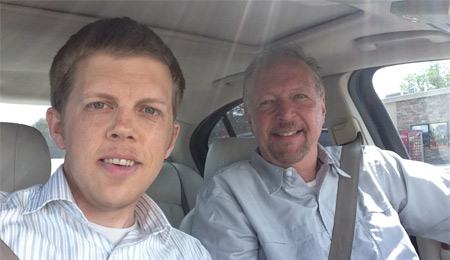My Experience Using Lyft to Get a Ride in Salt Lake City

Plenty of attention has been given in recent years to the newspaper industry, suffering one loss after another as advertisers flee to new markets and new technologies outpace old systems. This market disruption is nothing new, nor confined primarily to one or a few industries. It was satirized 170 years ago by Frédéric Bastiat in his humorous petition whereby candlemakers, whose livelihoods are threatened by the sun, call for its free and abundant light to be shut out.
The same disruption is now occurring in public transit. Enter Lyft and Uber, two young companies bringing the social networking revolution to transportation. These services pair drivers up with those who need a ride using geolocation on their mobile devices.
And because these emerging services pose a threat to longstanding institutions replete with their unionized and politically connected employees, it’s no surprise to see conflict. In Virginia, both companies were served a cease and desist last week by the state’s Department of Motor Vehicles because “the companies are illegal and have not received proper authorization from the DMV to operate in the state.” Both companies are wonderfully defiant of this order. For its part, Uber publicly announced its resistance, providing the following context:
Uber has set the standard for consumer safety in the Commonwealth. All uberX rides in Virginia are insured up to $1,000,000, nearly 300% more than the $350,000 required of for-hire drivers by the Virginia DMV. While the Virginia DMV does not require that all for-hire drivers pass background checks, all drivers on the Uber platform pass rigorous background checks at the county, state and federal level before they are ever allowed access to the technology. Our commitment to safety far exceeds the requirements set by the Virginia DMV – making their actions puzzling.
Police in Miami are conducting undercover stings, impounding the cars of Lyft or Uber drivers, and imposing fines of up to $2,000. All of this “for failing to get a chauffeur registration and for operating a for-hire vehicle without a valid for-hire license — both requirements for cabbies and limo operators.” And of course, taxi drivers themselves are protesting against their up-and-coming competitors.
Here in Utah, both companies have been given “warnings” in Salt Lake City. David Everitt, the city’s chief of staff, claims that there are “significant public welfare concerns” to shut down these services for failure to jump through its regulatory hoops. “Basic public safety, customer service and consistency issues are reasons that licensing is in place.” The city requires licensure, vehicle inspections, and background checks to drive another consenting passenger for payment; those who take people to or from the airport evidently must also be vetted by the TSA.
My experience yesterday using Lyft makes me ponder why any of that is necessary. The veiled threats and feigned concerns make sense from an economic protectionism standpoint—these companies pose a threat to stagnant business models. They make no sense from the “public welfare” standpoint.
I didn’t actually need a ride—I merely wanted to try out the service. I downloaded and opened the Lyft app, created an account, and then requested a ride. The closest driver in the area was alerted to my need, and within a few minutes arrived to get me. Steven, the driver, was in his 50s and drove a 2003 Jaguar in great condition—this was no dumpy taxi cab with worn seats and a pungent odor.
As I explained to Steven my purpose for the ride and my interest in this new business model, he grew excited and engaged me in an energetic, upbeat conversation. He related that he was a business owner with some time on his hands and was looking for a new revenue stream. “I’m a free market guy,” he told me, “so I’m really excited to watch this company grow and see if it proves to be viable.”
When I summarized the government threats that Lyft and Uber have been receiving, he appeared unsurprised. “Of course the taxi companies and their friends aren’t going to go down without a fight.” It’s a fight in which Steven is eager to be both participant and spectator.
He related that I was his third trip for the day. He has yet to pick up anybody 40 years of age or older, and most trips originate within the urban centers of Salt Lake City. “I’ve met some wonderful people; everybody is so nice,” he commented. We visited Jamba Juice to continue the conversation, and exchanged some stories about our past work experience, how we met our spouses, and where we grew up. In part because of the service’s novelty, but also because it was a different arrangement than the cold, transactional nature of taxi or shuttle services, there was an inherent interest in communicating on a friendly, open level. Every testimonial by drivers or passengers that I’ve come across from these services suggests that my experience was not an anomaly.
After Steven dropped me off, I was prompted to rate him and offer any comments. This ranking system is familiar to online exchanges such as Amazon, Yelp, and others, helping consumers make informed decisions as they navigate the marketplace. Of course, there’s no way to know what others think about your shuttle or taxi driver; while you can file complaints with the company after a bad experience, that’s not actionable information for potential passengers who might decide differently if they knew what had happened to you. This rating system is one of many incentives to ensure a good experience for both parties.
Steven’s interest in Lyft—he also is exploring becoming a driver with Uber—is not merely to make money. He is part entrepreneur, part evangelist. He called the service a “social experiment” and was eager to tout its benefits over traditional transportation models. In addition to taking passengers from point A to point B, he is also interested in making a friend.
Salt Lake City’s chief of staff expressed three reasons for targeting these services, so let’s look at them a little.
Public Safety
Lyft has hefty insurance coverage and performs background checks on each driver, as does Uber. The rating system mentioned previously serves to weed out bad actors. And at the end of the day, taxi drivers can cause harm to passengers as well.
Government agencies should take a wait-and-see approach before outright banning these companies. Bureaucrats do not make the best prognosticators; rather than claiming that there may in the future exist some public safety crisis as a result of their unlicensed operation, let’s let the market play out and see if the self-correcting mechanisms put in place are sufficient.
Customer Service
Steven showed up in about five minutes from the time I requested a driver. A taxi, based on my location, would likely have taken around 30 minutes (or more) just to get to where I was. That efficiency saves my time and increases my satisfaction as a customer.
Steven was also incentivized, to some degree, to be nice and service-oriented. He knew that at the end of the experience, I would be prompted to rate him with 1-5 stars and leave a comment. He knew that this data would be made available to future passengers, so his success as a driver is dependent upon obtaining good reviews from past passengers. No such feedback model exists for legacy transportation systems.
Additionally, the culture being built around these new services is one in which passengers are both called and treated as “friends.” In Lyft, drivers give you a fist bump when you enter the car, changing the relationship from disinterested driver and random passenger to friendly human beings sharing some time together. I found my experience with Lyft to be far superior in terms of customer service, and everything I’ve read about others’ experiences suggests the same.
Consistency
If you had $20 to spend on food, would you rather go to a large restaurant chain that offers homogenous, conveyor belt food, or a locally owned restaurant where the chef takes pride in his work? One offers “consistency” and the other offers more than food—it offers an experience.
The TSA, DMV, IRS, and other disliked government agencies offer a “consistent” experience, though this means little for the individual who objects to the experience to begin with. Consistency is not an ideal—quality is.
Diversity in commerce is a wonderful thing. I found Steven to be an interesting individual. We learned that we both grew up near the same area. We both met our wives online. We both went to BYU. It was enjoyable talking to him and learning about one another. Next time I use one of these services, I’ll have a different driver with a different life story. I look forward to the different experience, though the underlying service will remain the same.
Conclusion
Technology has disrupted many institutions and systems, and those who cling to old models—whether because of comfort, consistency, or the unwillingness or inability to adapt—publicly object and often seek political protectionism to prop up their failing business model. Such change should be welcomed, and not resisted.
While no process is perfect, my choice is clear: I will embrace technological adaptation, market disruption, entrepreneurialism, and good customer service. For the same reason I haven’t subscribed to a newspaper in ages, I’ll be steering clear of taxis and shuttles and searching out Lyft and Uber drivers in the future.

